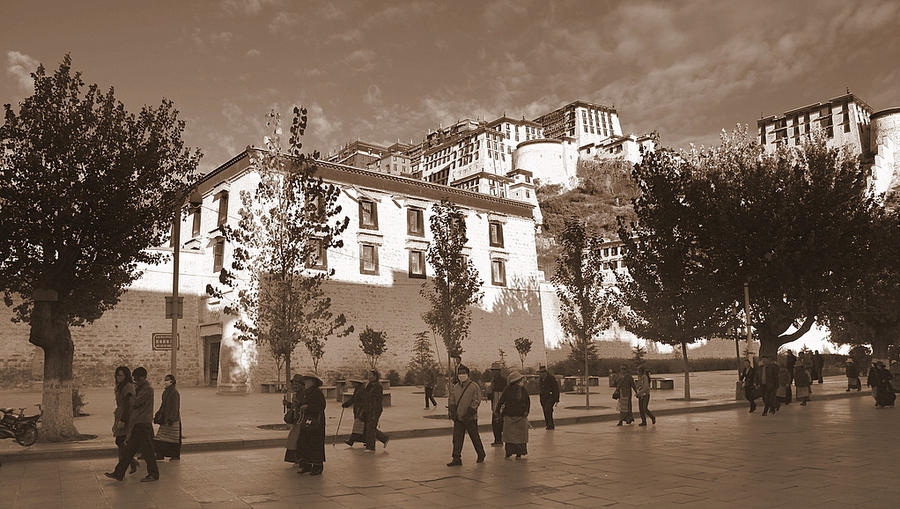ShopDreamUp AI ArtDreamUp
Deviation Actions
Description
Potala Palace, named after Mount Potala, was the main residence of the Dalai Lama until the 14th Dalai Lama fled to Dharamsala, India, after an invasion by the Chinese and a failed uprising in 1959. Today the Potala Palace has been converted into a museum by the Chinese government.
The building measures 400 metres east-west with sloping stone walls averaging 3 m. thick, and with copper poured into the foundations to help proof it against earthquakes. Two palaces -White and Red Palaces- have thirteen stories of buildings, containing over 1,000 rooms, 10,000 shrines and about 200,000 statues, rising more than 300m above the valley floor.
The site was used as a meditation retreat by King Songtsen Gampo, who in 637 built the first palace there, in order to greet his bride of the Tang Dynasty of China. Lozang Gyatso, the Great Fifth Dalai Lama, started the construction of the Potala Palace in 1645 after one of his spiritual advisers pointed out that the site was ideal as a seat of government, situated as it is between Drepung and Sera monasteries and the old city of Lhasa.
The Dalai Lama and his government moved into the Potrang Karpo ('White Palace') in 1649. The Potala was used as a winter palace by the Dalai Lama from that time. The Potrang Marpo ('Red Palace') was added between 1690 and 1694.
Red Palace is completely devoted to religious study and Buddhist prayer. It consists of a complicated layout of many different halls, chapels and libraries on many different levels with a complex array of smaller galleries and winding passages. It contains the sacred gold stupas—the tombs of eight Dalai Lamas—, with rich decorative painting, jewelled work and carving.
The White Palace is the secular part of the Potala Palace that makes up the living quarters of the Dalai Lama. It contains the living quarters, offices, the seminary and the printing house.
The palace was slightly damaged during the Tibetan uprising against the Chinese in 1959, when Chinese shells were launched into the palace's windows. It escaped damage during the Cultural Revolution in 1966 through the personal intervention of Zhou Enlai, who was then the Premier of the People's Republic of China. Still, almost all of the over 100,000 volumes of scriptures, historical documents and other works of art were either removed, damaged or destroyed.
The number of visitors to the palace is restricted to 2,300 daily, hence advance appointment is advised.
Source: [link]
The building measures 400 metres east-west with sloping stone walls averaging 3 m. thick, and with copper poured into the foundations to help proof it against earthquakes. Two palaces -White and Red Palaces- have thirteen stories of buildings, containing over 1,000 rooms, 10,000 shrines and about 200,000 statues, rising more than 300m above the valley floor.
The site was used as a meditation retreat by King Songtsen Gampo, who in 637 built the first palace there, in order to greet his bride of the Tang Dynasty of China. Lozang Gyatso, the Great Fifth Dalai Lama, started the construction of the Potala Palace in 1645 after one of his spiritual advisers pointed out that the site was ideal as a seat of government, situated as it is between Drepung and Sera monasteries and the old city of Lhasa.
The Dalai Lama and his government moved into the Potrang Karpo ('White Palace') in 1649. The Potala was used as a winter palace by the Dalai Lama from that time. The Potrang Marpo ('Red Palace') was added between 1690 and 1694.
Red Palace is completely devoted to religious study and Buddhist prayer. It consists of a complicated layout of many different halls, chapels and libraries on many different levels with a complex array of smaller galleries and winding passages. It contains the sacred gold stupas—the tombs of eight Dalai Lamas—, with rich decorative painting, jewelled work and carving.
The White Palace is the secular part of the Potala Palace that makes up the living quarters of the Dalai Lama. It contains the living quarters, offices, the seminary and the printing house.
The palace was slightly damaged during the Tibetan uprising against the Chinese in 1959, when Chinese shells were launched into the palace's windows. It escaped damage during the Cultural Revolution in 1966 through the personal intervention of Zhou Enlai, who was then the Premier of the People's Republic of China. Still, almost all of the over 100,000 volumes of scriptures, historical documents and other works of art were either removed, damaged or destroyed.
The number of visitors to the palace is restricted to 2,300 daily, hence advance appointment is advised.
Source: [link]
Image size
1024x578px 430.33 KB
Make
Canon
Model
Canon EOS 5D Mark II
Shutter Speed
1/512 second
Aperture
F/7.1
Focal Length
24 mm
ISO Speed
320
Date Taken
Oct 8, 2010, 3:41:37 AM
Lens
EF24-105mm f/4L IS USM
Sensor Size
6mm
© 2011 - 2024 Suppi-lu-liuma
Comments9
Join the community to add your comment. Already a deviant? Log In
Very nice shot!


































